EX-99.2
Published on January 15, 2021
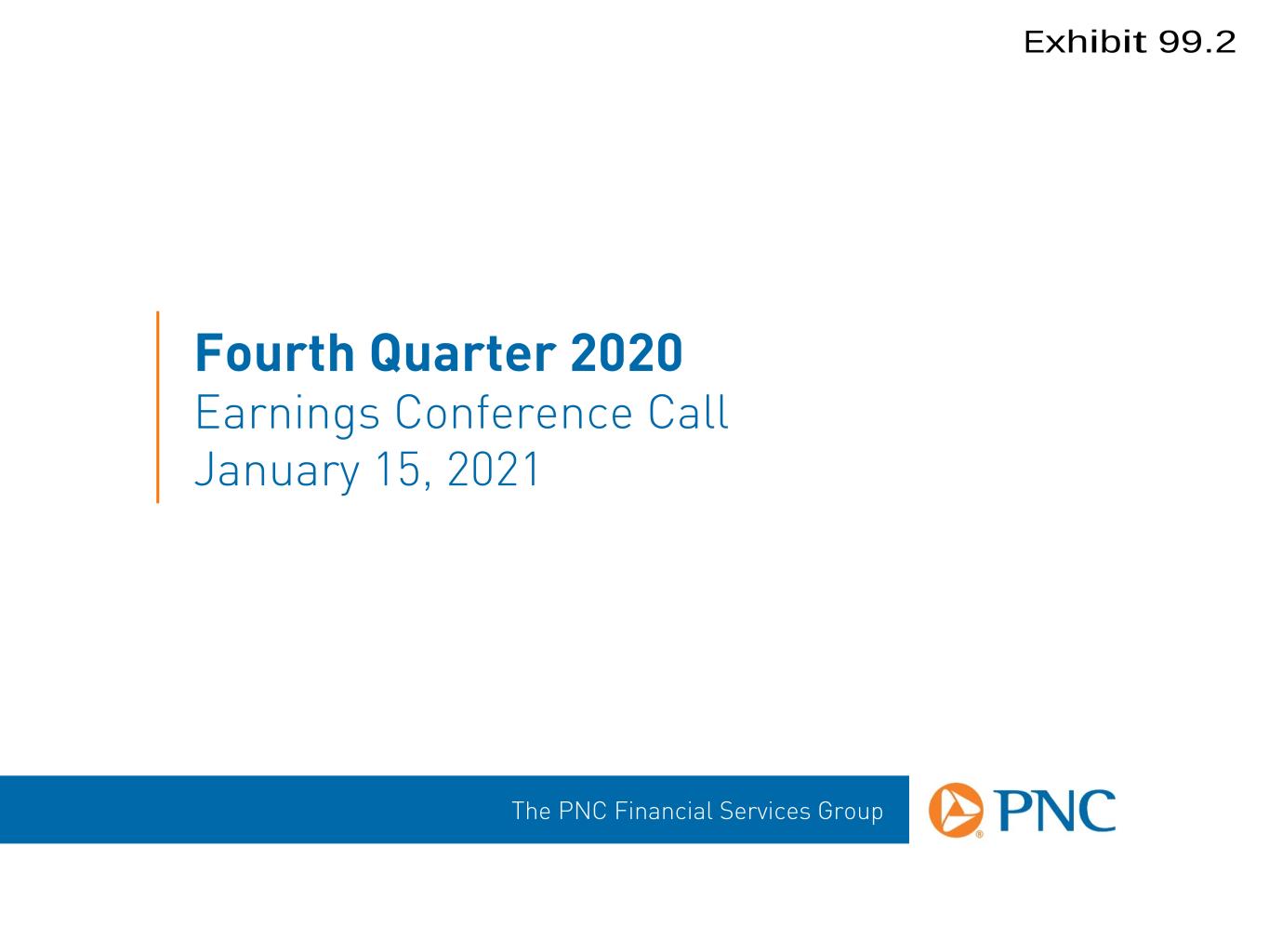
The PNC Financial Services Group Fourth Quarter 2020 Earnings Conference Call January 15, 2021 Exhibit 99.2
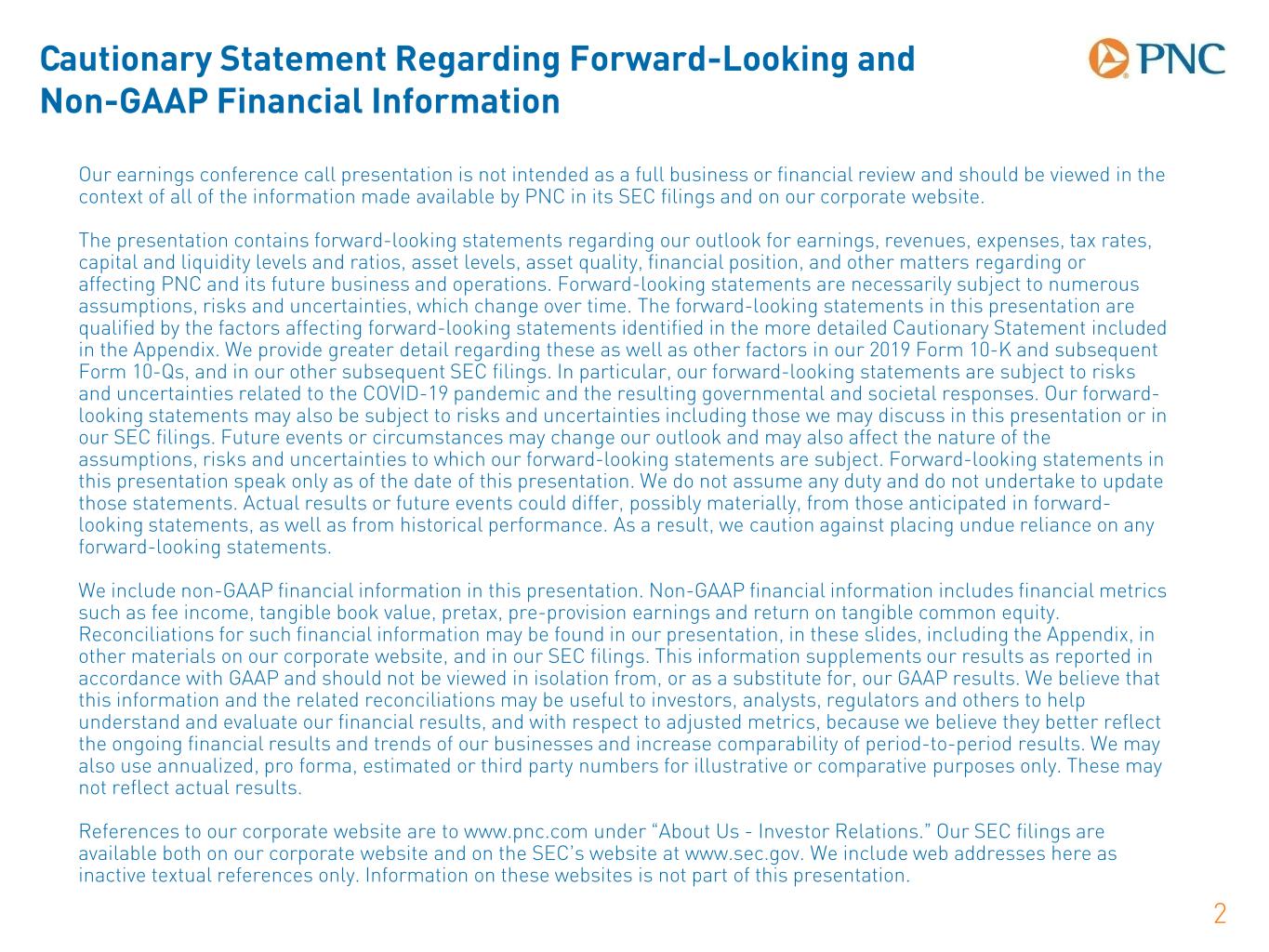
Cautionary Statement Regarding Forward-Looking and Non-GAAP Financial Information 2 Our earnings conference call presentation is not intended as a full business or financial review and should be viewed in the context of all of the information made available by PNC in its SEC filings and on our corporate website. The presentation contains forward-looking statements regarding our outlook for earnings, revenues, expenses, tax rates, capital and liquidity levels and ratios, asset levels, asset quality, financial position, and other matters regarding or affecting PNC and its future business and operations. Forward-looking statements are necessarily subject to numerous assumptions, risks and uncertainties, which change over time. The forward-looking statements in this presentation are qualified by the factors affecting forward-looking statements identified in the more detailed Cautionary Statement included in the Appendix. We provide greater detail regarding these as well as other factors in our 2019 Form 10-K and subsequent Form 10-Qs, and in our other subsequent SEC filings. In particular, our forward-looking statements are subject to risks and uncertainties related to the COVID-19 pandemic and the resulting governmental and societal responses. Our forward- looking statements may also be subject to risks and uncertainties including those we may discuss in this presentation or in our SEC filings. Future events or circumstances may change our outlook and may also affect the nature of the assumptions, risks and uncertainties to which our forward-looking statements are subject. Forward-looking statements in this presentation speak only as of the date of this presentation. We do not assume any duty and do not undertake to update those statements. Actual results or future events could differ, possibly materially, from those anticipated in forward- looking statements, as well as from historical performance. As a result, we caution against placing undue reliance on any forward-looking statements. We include non-GAAP financial information in this presentation. Non-GAAP financial information includes financial metrics such as fee income, tangible book value, pretax, pre-provision earnings and return on tangible common equity. Reconciliations for such financial information may be found in our presentation, in these slides, including the Appendix, in other materials on our corporate website, and in our SEC filings. This information supplements our results as reported in accordance with GAAP and should not be viewed in isolation from, or as a substitute for, our GAAP results. We believe that this information and the related reconciliations may be useful to investors, analysts, regulators and others to help understand and evaluate our financial results, and with respect to adjusted metrics, because we believe they better reflect the ongoing financial results and trends of our businesses and increase comparability of period-to-period results. We may also use annualized, pro forma, estimated or third party numbers for illustrative or comparative purposes only. These may not reflect actual results. References to our corporate website are to www.pnc.com under “About Us - Investor Relations.” Our SEC filings are available both on our corporate website and on the SEC’s website at www.sec.gov. We include web addresses here as inactive textual references only. Information on these websites is not part of this presentation.
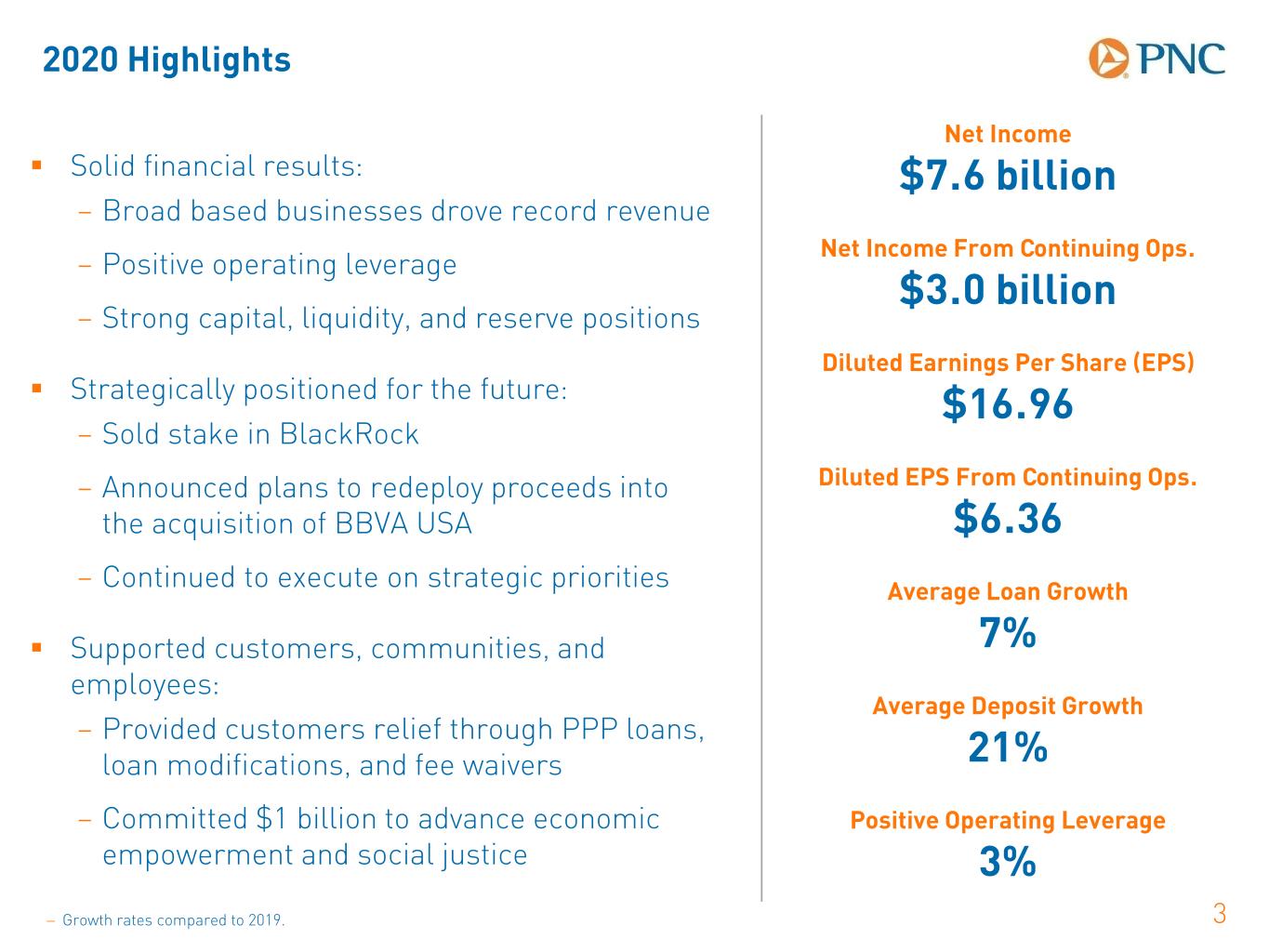
2020 Highlights 3 Solid financial results: – Broad based businesses drove record revenue – Positive operating leverage – Strong capital, liquidity, and reserve positions Strategically positioned for the future: – Sold stake in BlackRock – Announced plans to redeploy proceeds into the acquisition of BBVA USA – Continued to execute on strategic priorities Supported customers, communities, and employees: – Provided customers relief through PPP loans, loan modifications, and fee waivers – Committed $1 billion to advance economic empowerment and social justice − Growth rates compared to 2019. Net Income $7.6 billion Diluted Earnings Per Share (EPS) $16.96 Average Loan Growth 7% Average Deposit Growth 21% Positive Operating Leverage 3% Diluted EPS From Continuing Ops. $6.36 Net Income From Continuing Ops. $3.0 billion
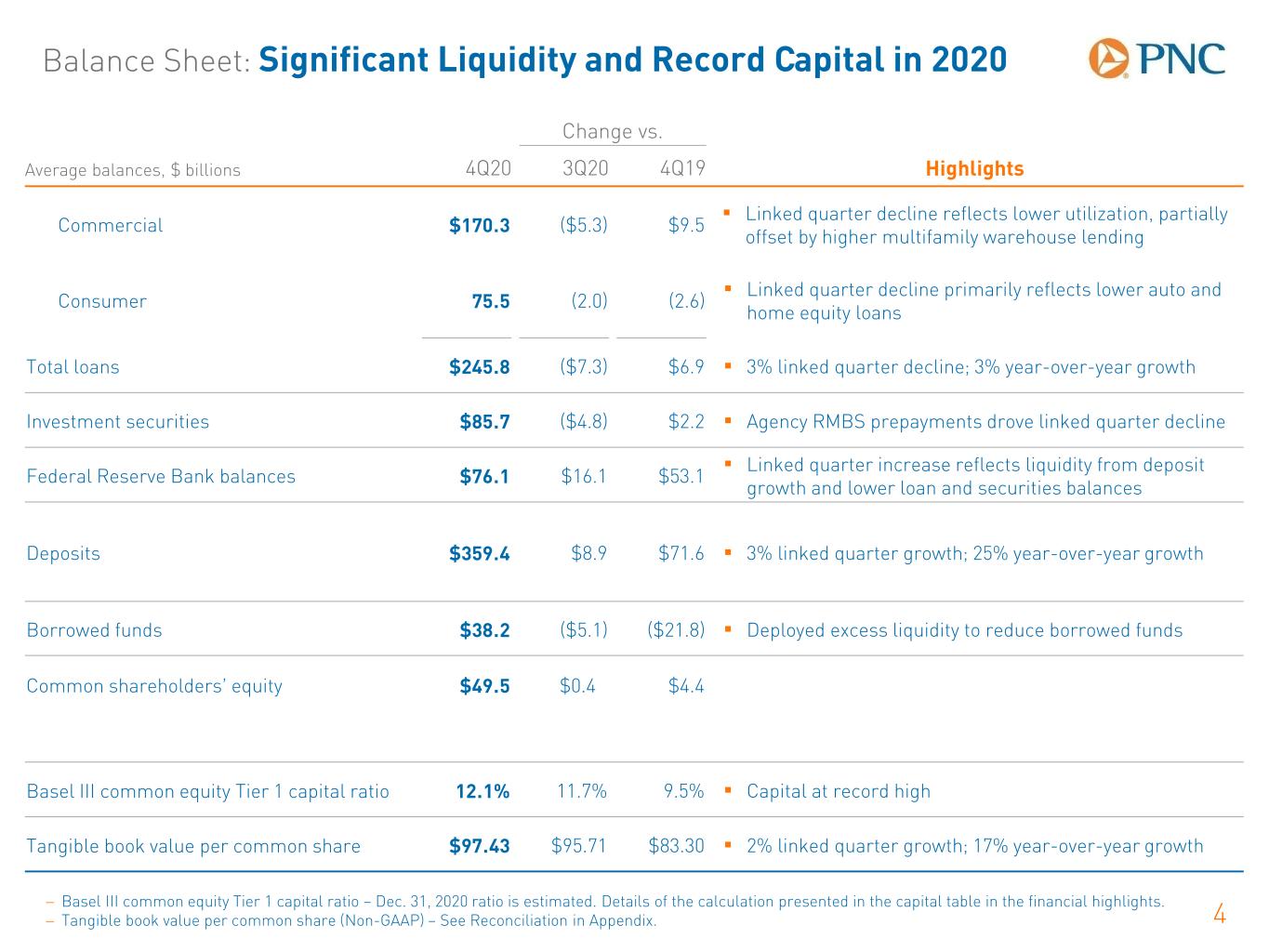
Change vs. Average balances, $ billions 4Q20 3Q20 4Q19 Highlights Commercial $170.3 ($5.3) $9.5 Linked quarter decline reflects lower utilization, partially offset by higher multifamily warehouse lending Consumer 75.5 (2.0) (2.6) Linked quarter decline primarily reflects lower auto and home equity loans Total loans $245.8 ($7.3) $6.9 3% linked quarter decline; 3% year-over-year growth Investment securities $85.7 ($4.8) $2.2 Agency RMBS prepayments drove linked quarter decline Federal Reserve Bank balances $76.1 $16.1 $53.1 Linked quarter increase reflects liquidity from deposit growth and lower loan and securities balances Deposits $359.4 $8.9 $71.6 3% linked quarter growth; 25% year-over-year growth Borrowed funds $38.2 ($5.1) ($21.8) Deployed excess liquidity to reduce borrowed funds Common shareholders’ equity $49.5 $0.4 $4.4 Basel III common equity Tier 1 capital ratio 12.1% 11.7% 9.5% Capital at record high Tangible book value per common share $97.43 $95.71 $83.30 2% linked quarter growth; 17% year-over-year growth Balance Sheet: Significant Liquidity and Record Capital in 2020 4 − Basel III common equity Tier 1 capital ratio – Dec. 31, 2020 ratio is estimated. Details of the calculation presented in the capital table in the financial highlights. − Tangible book value per common share (Non-GAAP) – See Reconciliation in Appendix.

5 Balance Sheet: Well Positioned with Substantial Low Cost Funding A ve ra ge b al an ce s, $ b ill io n s $238.9 $243.6 $268.1 $253.1 $245.8 $287.8 $289.7 $335.2 $350.5 $359.4 83% 87% 75% 70% 66% 50% 60% 70% 80% 90% 100% 110% 120% 130% 0 50 100 150 200 250 300 350 400 4Q19 1Q20 2Q20 3Q20 4Q20 Loans Deposits Spot Loan / Deposit Ratio Loan Yield Deposit Cost 4.27% 4.08% 3.37% 3.32% 3.35% 0.87% 0.70% 0.23% 0.12% 0.08% Loans and Deposits 3% YoY Growth in Loans; 25% YoY Growth in Deposits

Income Statement: Solid Results in a Challenging Environment 6 Change vs. Change vs. $ millions 4Q20 3Q20 FY20 FY19 Full Year Highlights Revenue $4,208 ($73) $16,901 62 Record full year revenue Noninterest expense $2,708 $177 $10,297 ($277) Full year expenses well-controlled; down 3% Pretax, pre-provision earnings $1,500 ($250) $6,604 $339 Grew pretax, pre-provision earnings 5% Provision for (recapture of) credit losses ($254) ($306) $3,175 $2,402 Bolstered reserves in response to COVID-19 impacts on the economic environment Net income from continuing ops. $1,456 ($76) $3,003 ($1,588) Revenue growth and expense control more than offset by significant increase in provision 4Q20 3Q20 FY20 FY19 Efficiency ratio 64% 59% 61% 63% Positive operating leverage of 3% Net interest margin 2.32% 2.39% 2.53% 2.89% Lower rates and higher balances held at the Fed Diluted EPS from continuing ops. $3.26 $3.39 $6.36 $9.57 Decline is a result of significant increase in provision − Pretax, pre-provision earnings (Non-GAAP) – See Reconciliation in Appendix. − FY – Full Year.

$6,144 $6,469 $6,874 $6,955 $9,108 $9,721 $9,965 $9,946 $15,252 $16,190 $16,839 $16,901 2.87% 2.97% 2.89% 2.53% 1.80% 2.00% 2.20% 2.40% 2.60% 2.80% 3.00% 3.20% 3.40% 0 2000 4000 6000 8000 10000 12000 14000 16000 18000 20000 2017 2018 2019 2020 Noninterest Income NII NIM 7 Income Statement: Broad Based Businesses Drove Record Revenue Total Revenue − NII – Net Interest Income. − NIM – Net Interest Margin. 3% Compound Annual Growth Rate Details of Total Revenue Full Year Increase Led by 4% Growth in Fee Income $ m ill io n s Change vs. Change vs. $ millions 4Q20 3Q20 FY20 FY19 Net interest income $2,424 ($60) $9,946 ($19) Asset management $221 $6 $836 ($26) Consumer services 387 (3) 1,484 (71) Corporate services 650 171 2,167 253 Residential mortgage 99 (38) 604 236 Service charges on deposits 134 15 500 (202) Fee income $1,491 $151 $5,591 $190 Other noninterest income 293 (164) 1,364 (109) Noninterest income $1,784 ($13) $6,955 $81 Total revenue $4,208 ($73) $16,901 $62 $62
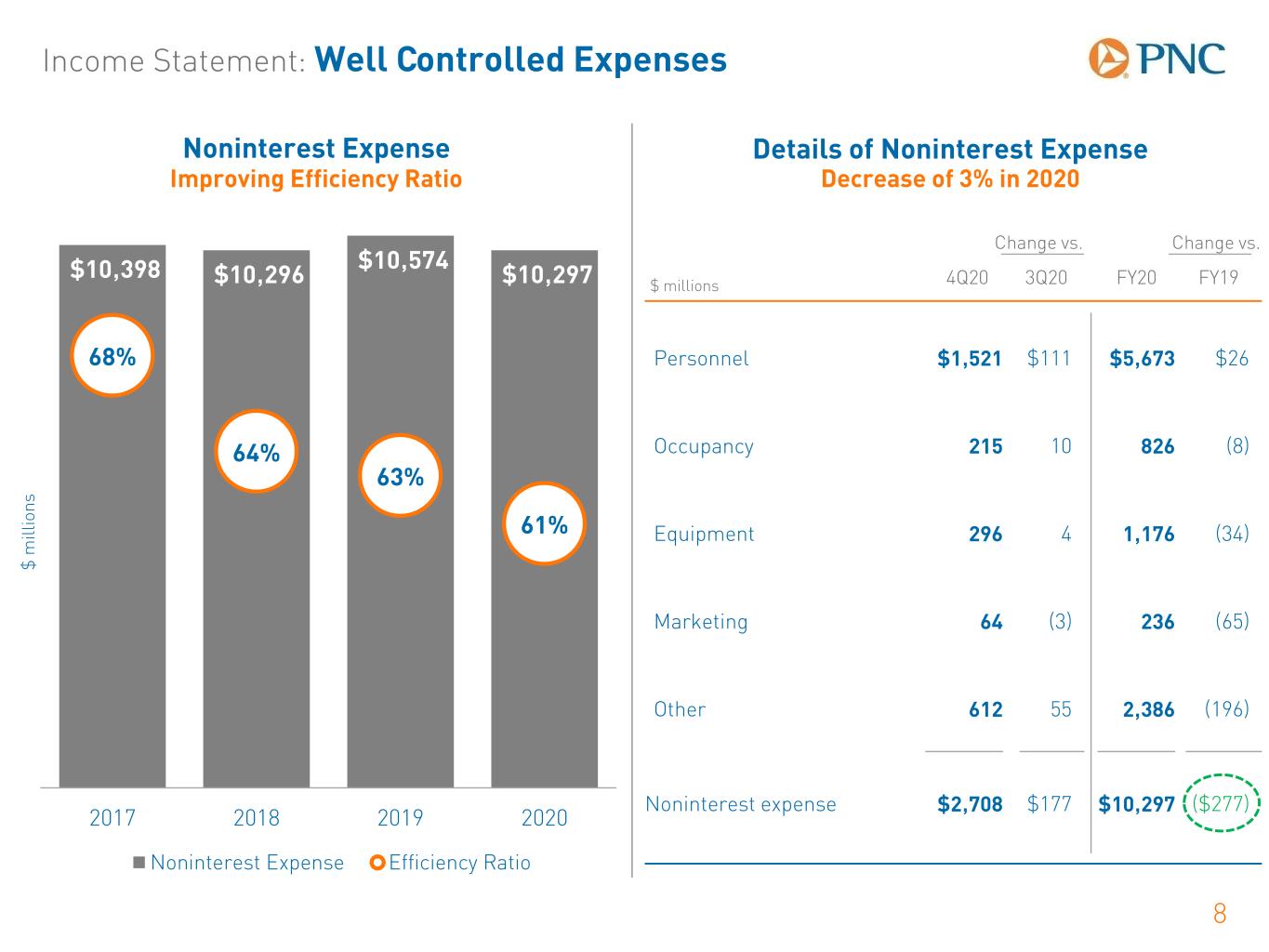
$10,398 $10,296 $10,574 $10,297 68% 64% 63% 61% 50.00% 55.00% 60.00% 65.00% 70.00% 75.00% 0 2000 4000 6000 8000 10000 2017 2018 2019 2020 Noninterest Expense Efficiency Ratio 8 Income Statement: Well Controlled Expenses Noninterest Expense Improving Efficiency Ratio Details of Noninterest Expense $ m ill io n s Change vs. Change vs. $ millions 4Q20 3Q20 FY20 FY19 Personnel $1,521 $111 $5,673 $26 Occupancy 215 10 826 (8) Equipment 296 4 1,176 (34) Marketing 64 (3) 236 (65) Other 612 55 2,386 (196) Noninterest expense $2,708 $177 $10,297 ($277) Decrease of 3% in 2020
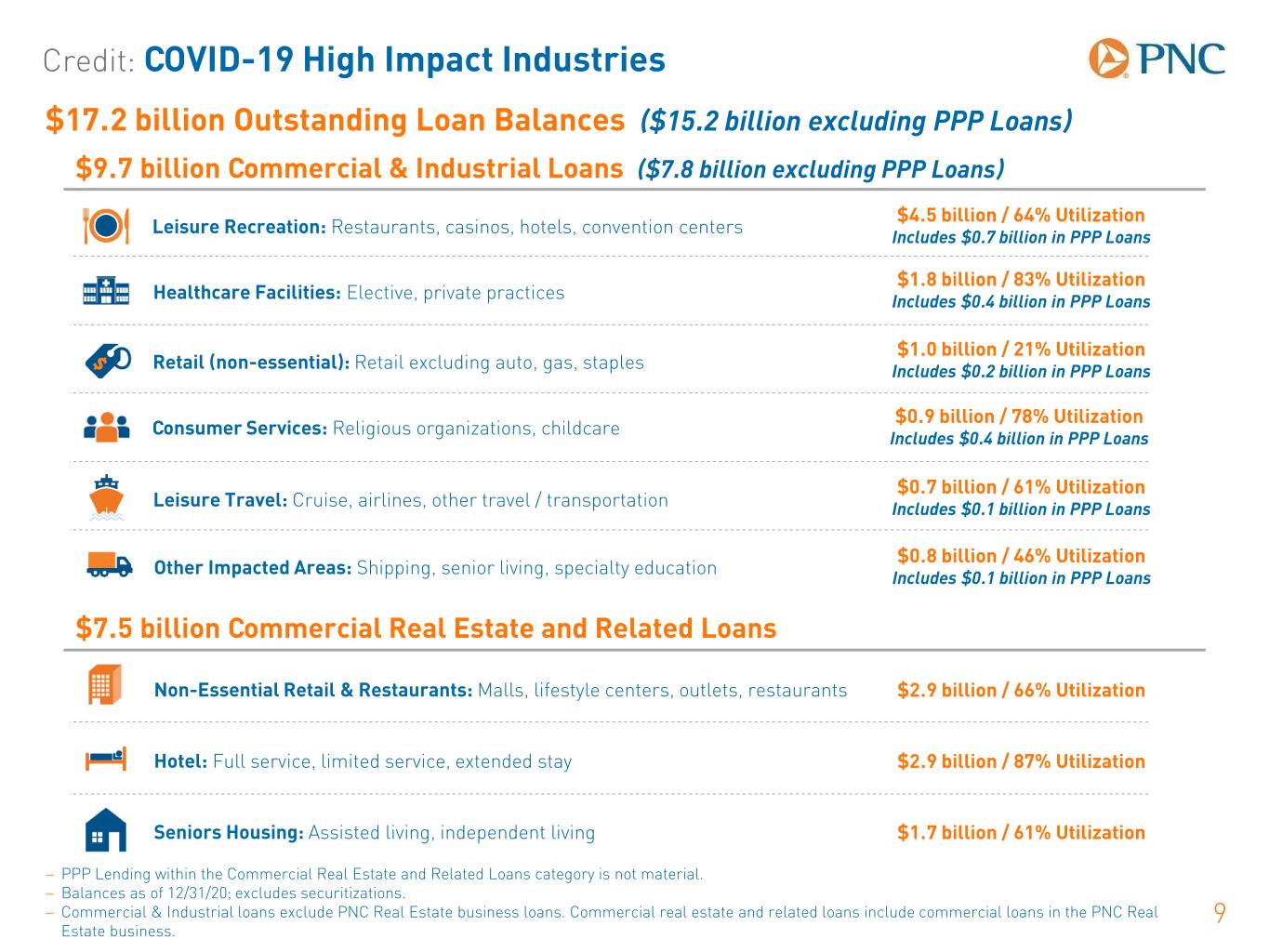
Credit: COVID-19 High Impact Industries 9 $9.7 billion Commercial & Industrial Loans ($7.8 billion excluding PPP Loans) $7.5 billion Commercial Real Estate and Related Loans Leisure Recreation: Restaurants, casinos, hotels, convention centers Healthcare Facilities: Elective, private practices Other Impacted Areas: Shipping, senior living, specialty education Consumer Services: Religious organizations, childcare $4.5 billion / 64% Utilization Includes $0.7 billion in PPP Loans $1.8 billion / 83% Utilization Includes $0.4 billion in PPP Loans $0.8 billion / 46% Utilization Includes $0.1 billion in PPP Loans Non-Essential Retail & Restaurants: Malls, lifestyle centers, outlets, restaurants Hotel: Full service, limited service, extended stay Seniors Housing: Assisted living, independent living $2.9 billion / 66% Utilization $2.9 billion / 87% Utilization $1.7 billion / 61% Utilization $0.9 billion / 78% Utilization Includes $0.4 billion in PPP Loans Leisure Travel: Cruise, airlines, other travel / transportation $0.7 billion / 61% Utilization Includes $0.1 billion in PPP Loans − PPP Lending within the Commercial Real Estate and Related Loans category is not material. − Balances as of 12/31/20; excludes securitizations. − Commercial & Industrial loans exclude PNC Real Estate business loans. Commercial real estate and related loans include commercial loans in the PNC Real Estate business. $17.2 billion Outstanding Loan Balances ($15.2 billion excluding PPP Loans) Retail (non-essential): Retail excluding auto, gas, staples $1.0 billion / 21% Utilization Includes $0.2 billion in PPP Loans
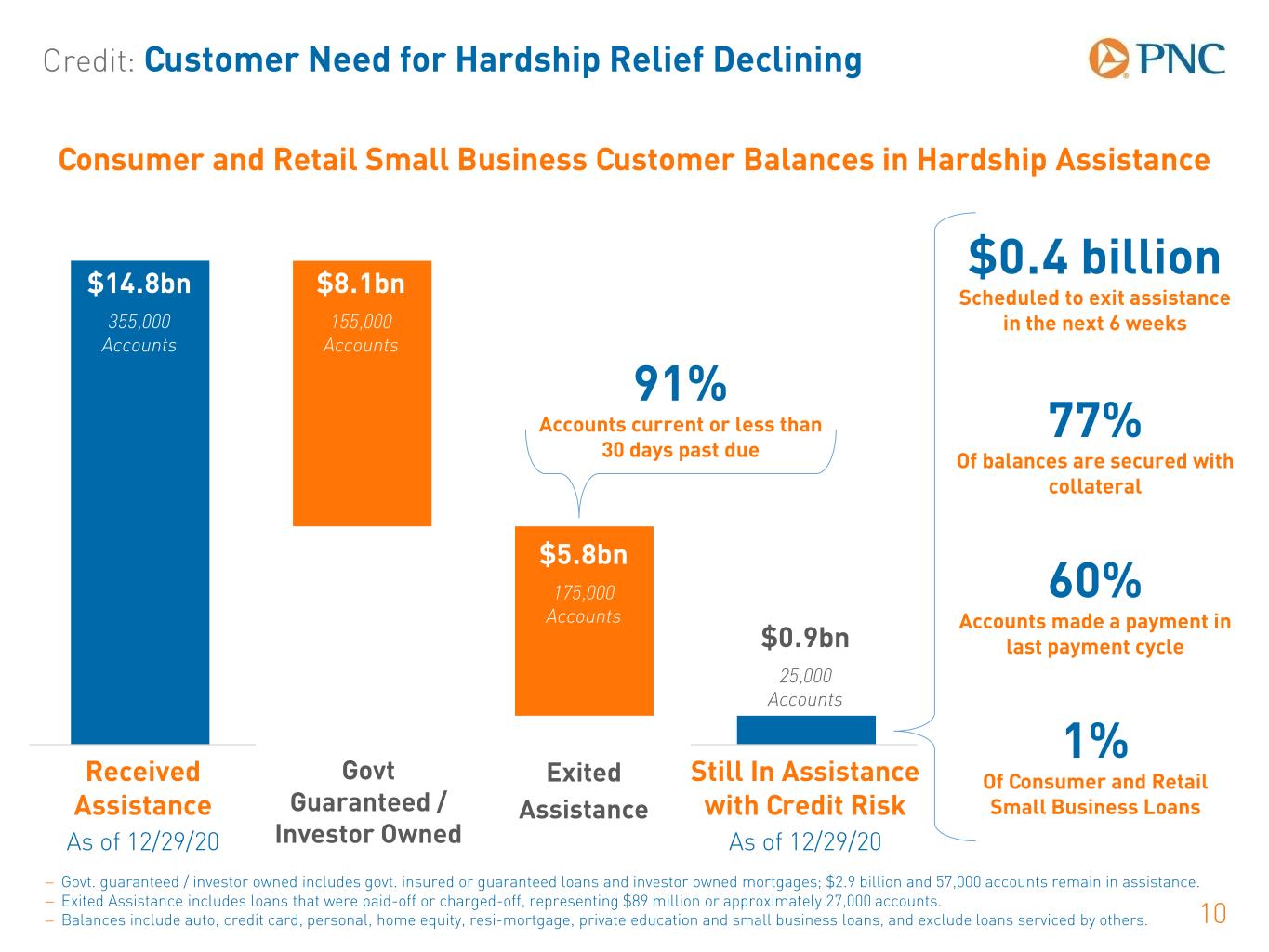
10 Credit: Customer Need for Hardship Relief Declining Consumer and Retail Small Business Customer Balances in Hardship Assistance − Govt. guaranteed / investor owned includes govt. insured or guaranteed loans and investor owned mortgages; $2.9 billion and 57,000 accounts remain in assistance. − Exited Assistance includes loans that were paid-off or charged-off, representing $89 million or approximately 27,000 accounts. − Balances include auto, credit card, personal, home equity, resi-mortgage, private education and small business loans, and exclude loans serviced by others. Received Assistance As of 12/29/20 $0.9bn 25,000 Accounts $0.4 billion Scheduled to exit assistance in the next 6 weeks 60% Accounts made a payment in last payment cycle 1% Of Consumer and Retail Small Business Loans 91% Accounts current or less than 30 days past due 77% Of balances are secured with collateral Govt Guaranteed / Investor Owned Exited Assistance Still In Assistance with Credit Risk As of 12/29/20 1 2 3 4 $8.1bn 155,000 Accounts $14.8bn 355,000 Accounts $5.8bn 175,000 Accounts
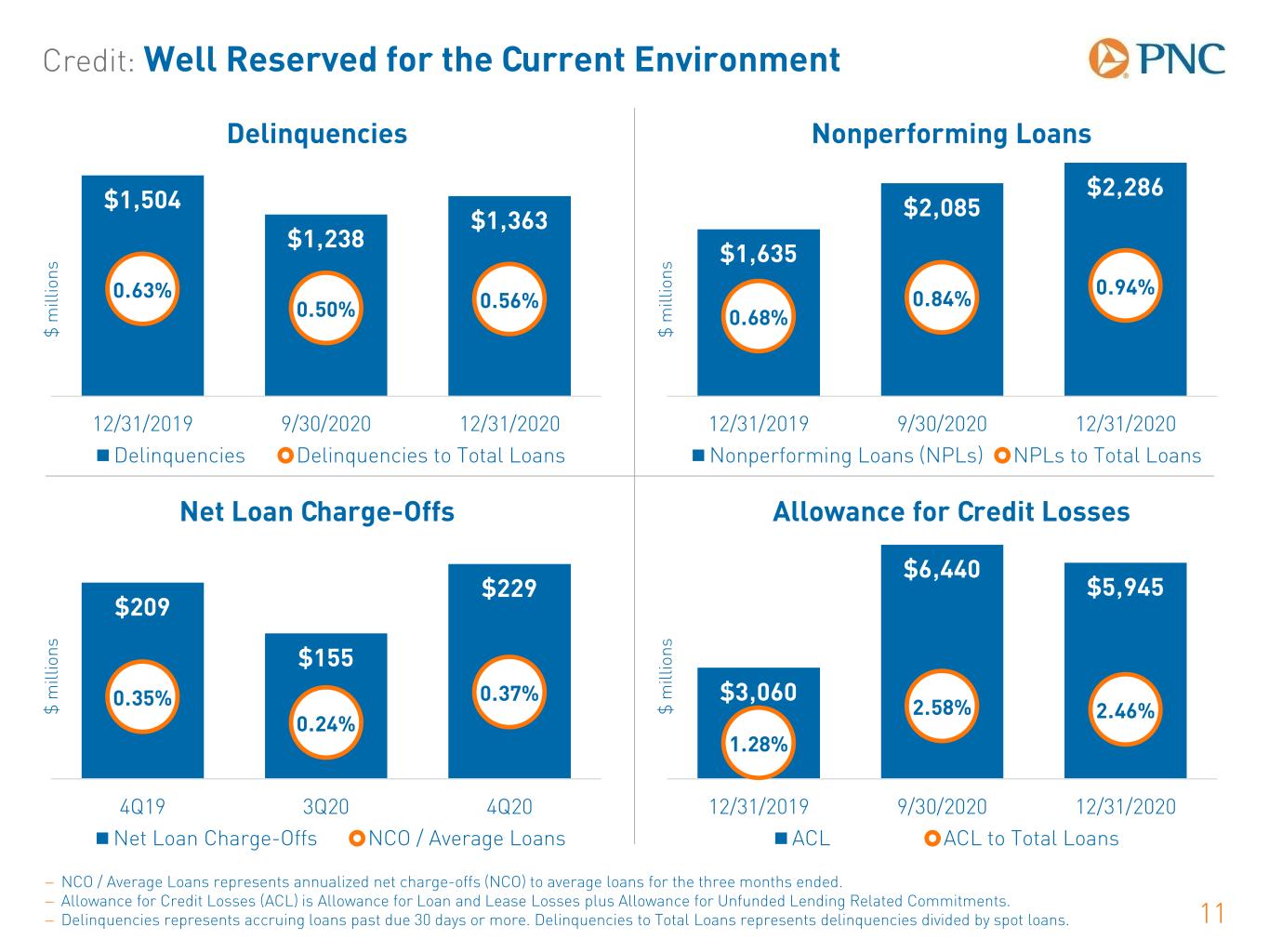
11 Credit: Well Reserved for the Current Environment − NCO / Average Loans represents annualized net charge-offs (NCO) to average loans for the three months ended. − Allowance for Credit Losses (ACL) is Allowance for Loan and Lease Losses plus Allowance for Unfunded Lending Related Commitments. − Delinquencies represents accruing loans past due 30 days or more. Delinquencies to Total Loans represents delinquencies divided by spot loans. $ m ill io n s $ m ill io n s $ m ill io n s $ m ill io n s Delinquencies Nonperforming Loans Net Loan Charge-Offs Allowance for Credit Losses $209 $155 $229 0.35% 0.24% 0.37% 0 0.002 0.004 0.006 0.008 0.01 0 50 100 150 200 250 4Q19 3Q20 4Q20 Net Loan Charge-Offs NCO / Average Loans $3,060 $6,440 $5,945 1.28% 2.58% 2.46% 0 0.01 0.02 0.03 0.04 0.05 0.06 0.07 0.08 0 1000 2000 3000 4000 5000 6000 12/31/2019 9/30/2020 12/31/2020 ACL ACL to Total Loans $1,504 $1,238 $1,363 0.63% 0.50% 0.56% -0.001 0.001 0.003 0.005 0.007 0.009 0.011 0.013 0.015 0 200 400 600 800 1000 1200 1400 1600 12/31/2019 9/30/2020 12/31/2020 Delinquencies Delinquencies to Total Loans $1,635 $2,085 $2,286 0.68% 0.84% 0.94% 0 0.005 0.01 0.015 0.02 0 500 1000 1500 2000 12/31/2019 9/30/2020 12/31/2020 Nonperforming Loans (NPLs) NPLs to Total Loans
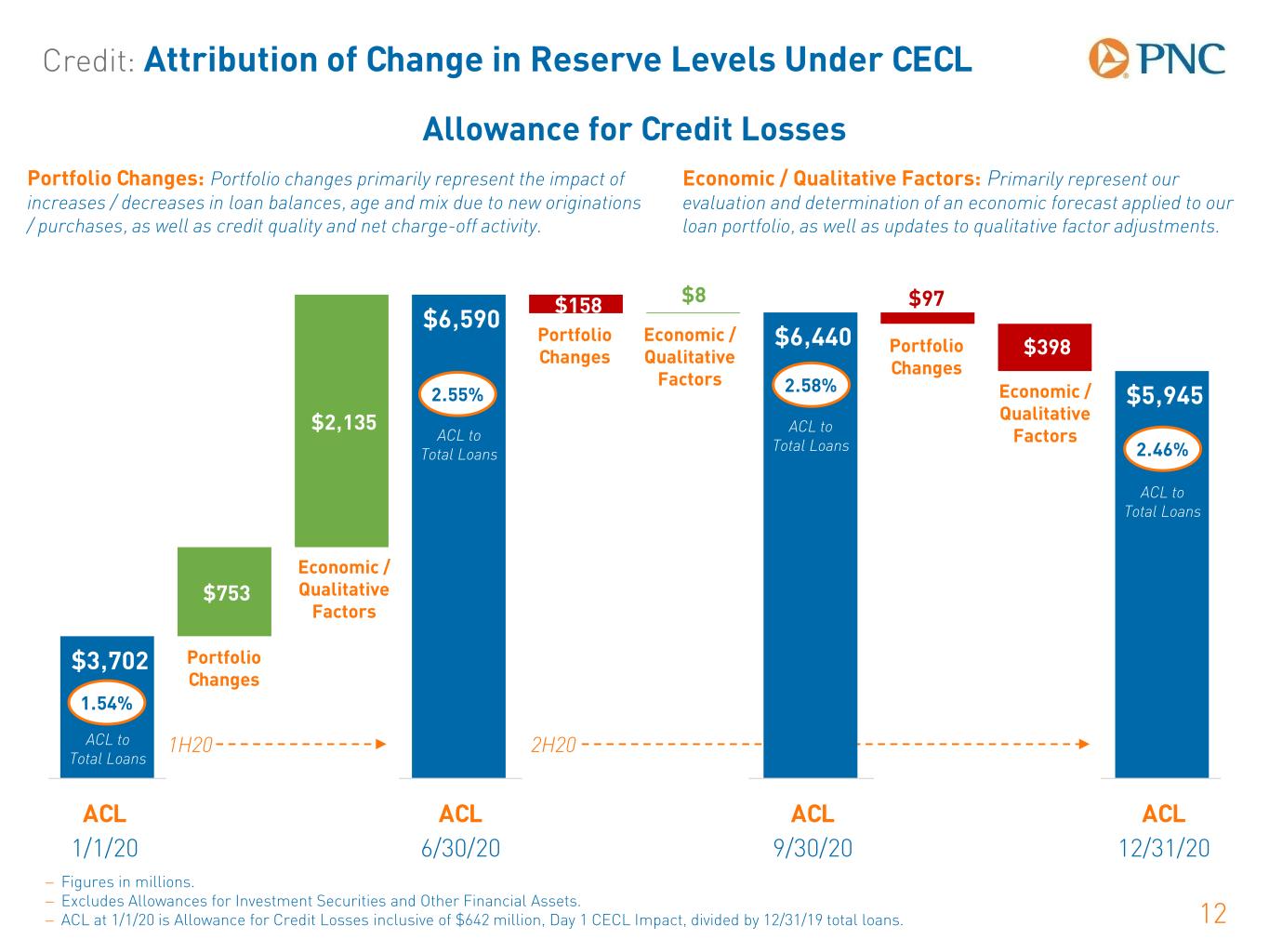
$3,702 $6,590 $6,440 $5,945 $753 $2,135 $158 $8 $97 $398 1 2 3 4 5 6 7 8 9 10 12 Credit: Attribution of Change in Reserve Levels Under CECL − Figures in millions. − Excludes Allowances for Investment Securities and Other Financial Assets. − ACL at 1/1/20 is Allowance for Credit Losses inclusive of $642 million, Day 1 CECL Impact, divided by 12/31/19 total loans. Allowance for Credit Losses ACL 1/1/20 ACL 12/31/20 ACL 9/30/20 ACL 6/30/20 Portfolio Changes Portfolio Changes Portfolio Changes Economic / Qualitative Factors Economic / Qualitative Factors Economic / Qualitative Factors Portfolio Changes: Portfolio changes primarily represent the impact of increases / decreases in loan balances, age and mix due to new originations / purchases, as well as credit quality and net charge-off activity. Economic / Qualitative Factors: Primarily represent our evaluation and determination of an economic forecast applied to our loan portfolio, as well as updates to qualitative factor adjustments. ACL to Total Loans 2.46% ACL to Total Loans 2.55% ACL to Total Loans 2.58% ACL to Total Loans 1.54% 1H20 2H20
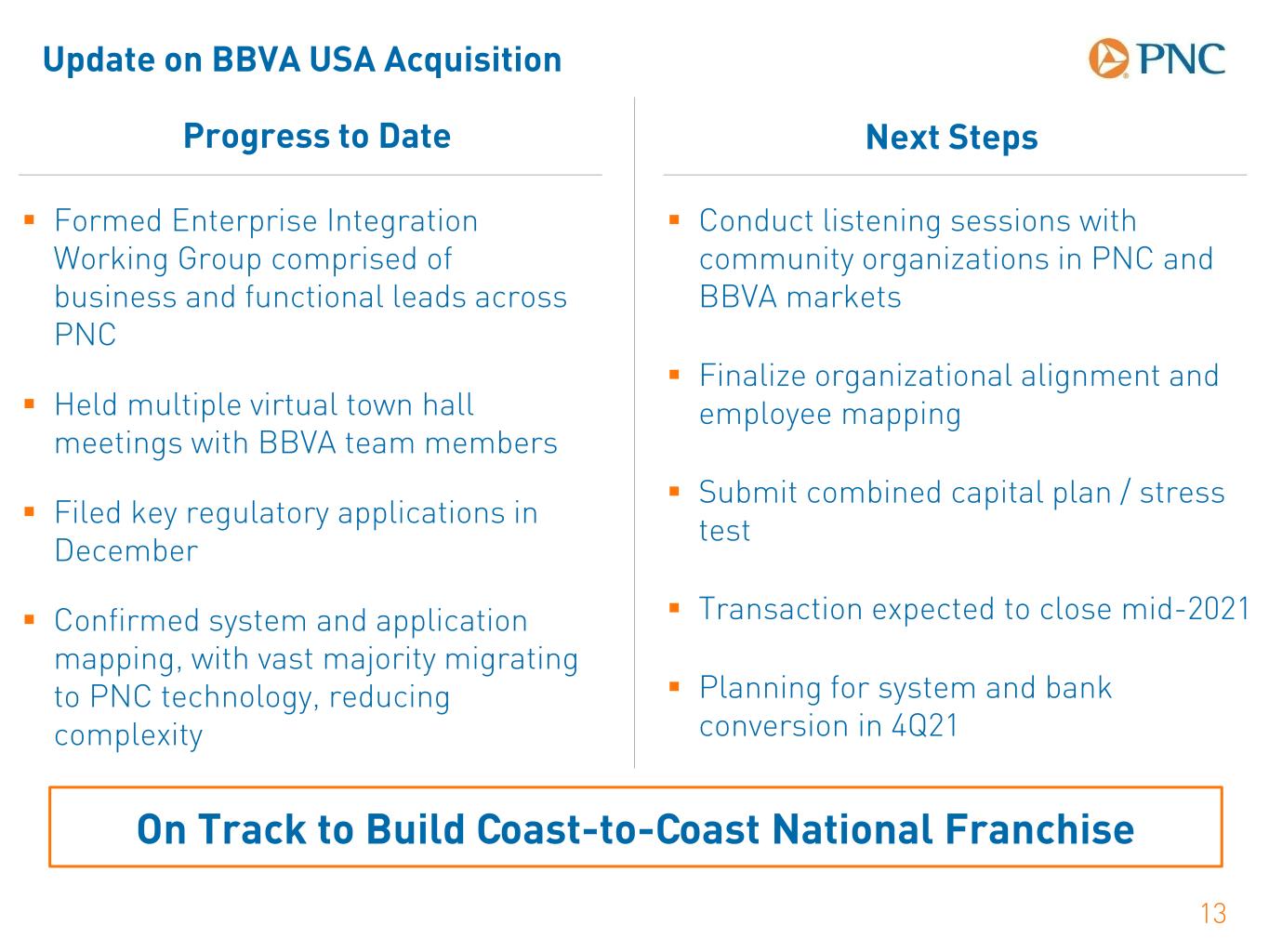
Update on BBVA USA Acquisition 13 Progress to Date Next Steps Formed Enterprise Integration Working Group comprised of business and functional leads across PNC Held multiple virtual town hall meetings with BBVA team members Filed key regulatory applications in December Confirmed system and application mapping, with vast majority migrating to PNC technology, reducing complexity Conduct listening sessions with community organizations in PNC and BBVA markets Finalize organizational alignment and employee mapping Submit combined capital plan / stress test Transaction expected to close mid-2021 Planning for system and bank conversion in 4Q21 On Track to Build Coast-to-Coast National Franchise
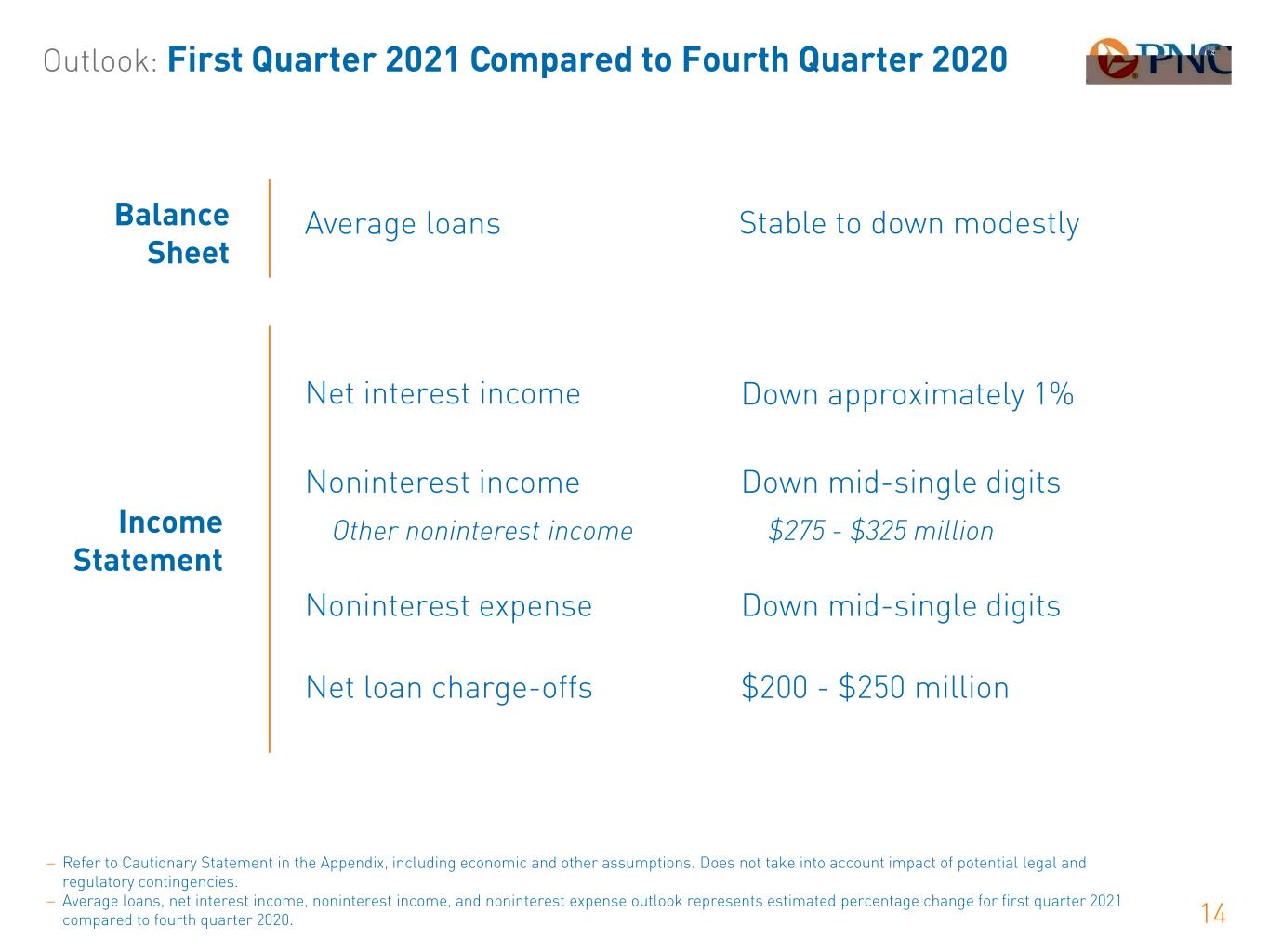
Outlook: First Quarter 2021 Compared to Fourth Quarter 2020 14 − Refer to Cautionary Statement in the Appendix, including economic and other assumptions. Does not take into account impact of potential legal and regulatory contingencies. − Average loans, net interest income, noninterest income, and noninterest expense outlook represents estimated percentage change for first quarter 2021 compared to fourth quarter 2020. Balance Sheet Net interest income Down approximately 1% Noninterest income Down mid-single digits Other noninterest income $275 - $325 million Noninterest expense Down mid-single digits Net loan charge-offs $200 - $250 million Average loans Stable to down modestly Income Statement

Outlook: PNC Standalone FY 2021 Compared to FY 2020 15 − Refer to Cautionary Statement in the Appendix, including economic and other assumptions. Does not take into account impact of potential legal and regulatory contingencies. − Average loans, revenue and noninterest expense outlook represents estimated percentage change for PNC standalone full year 2021 compared to full year 2020. Income Statement Revenue Stable Noninterest expense Stable Effective tax rate 17% Average loans Down low-single digitsBalance Sheet

This presentation includes “snapshot” information about PNC used by way of illustration and is not intended as a full business or financial review. It should not be viewed in isolation but rather in the context of all of the information made available by PNC in its SEC filings. We also make statements in this presentation, and we may from time to time make other statements, regarding our outlook for earnings, revenues, expenses, tax rates, capital and liquidity levels and ratios, asset levels, asset quality, financial position, and other matters regarding or affecting PNC and its future business and operations that are forward-looking statements within the meaning of the Private Securities Litigation Reform Act. Forward-looking statements are typically identified by words such as “believe,” “plan,” “expect,” “anticipate,” “see,” “look,” “intend,” “outlook,” “project,” “forecast,” “estimate,” “goal,” “will,” “should” and other similar words and expressions. Forward-looking statements are necessarily subject to numerous assumptions, risks and uncertainties, which change over time. Future events or circumstances may change our outlook and may also affect the nature of the assumptions, risks and uncertainties to which our forward-looking statements are subject. Forward-looking statements speak only as of the date made. We do not assume any duty and do not undertake to update forward-looking statements. Actual results or future events could differ, possibly materially, from those anticipated in forward-looking statements, as well as from historical performance. As a result, we caution against placing undue reliance on any forward-looking statements. Our forward-looking statements are subject to the following principal risks and uncertainties. Our businesses, financial results and balance sheet values are affected by business and economic conditions, including the following: − Changes in interest rates and valuations in debt, equity and other financial markets. − Disruptions in the U.S. and global financial markets. − Actions by the Federal Reserve Board, U.S. Treasury and other government agencies, including those that impact money supply and market interest rates. − Changes in customer behavior due to changing business and economic conditions or legislative or regulatory initiatives. − Changes in customers’, suppliers’ and other counterparties’ performance and creditworthiness. − Impacts of tariffs and other trade policies of the U.S. and its global trading partners. − The length and extent of the economic impact of the COVID-19 pandemic. − The impact of the results of the recent U.S. elections on the regulatory landscape, capital markets, and the response to and management of the COVID-19 pandemic. − Commodity price volatility. 16 Appendix: Cautionary Statement Regarding Forward-Looking Information
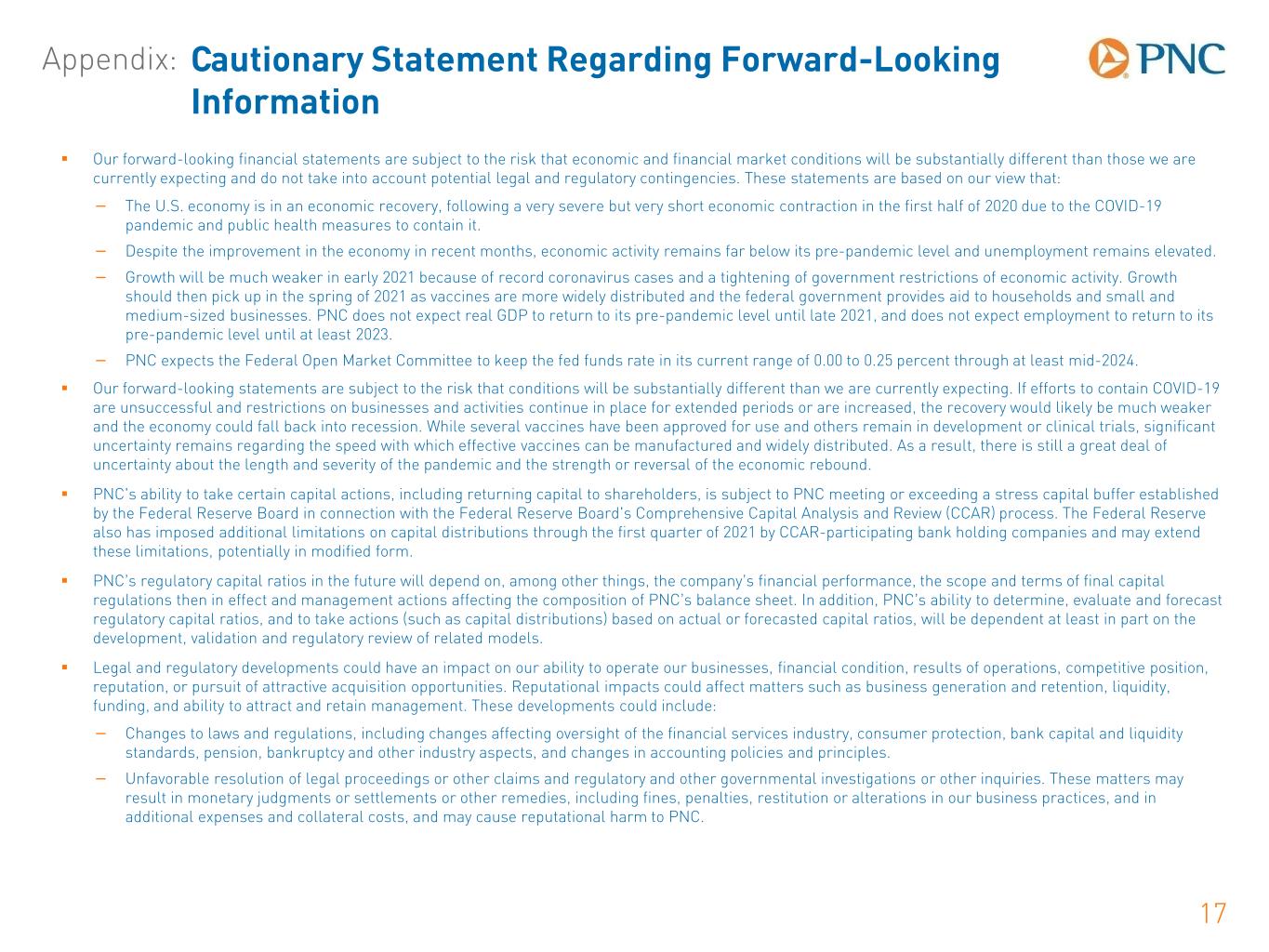
Our forward-looking financial statements are subject to the risk that economic and financial market conditions will be substantially different than those we are currently expecting and do not take into account potential legal and regulatory contingencies. These statements are based on our view that: − The U.S. economy is in an economic recovery, following a very severe but very short economic contraction in the first half of 2020 due to the COVID-19 pandemic and public health measures to contain it. − Despite the improvement in the economy in recent months, economic activity remains far below its pre-pandemic level and unemployment remains elevated. − Growth will be much weaker in early 2021 because of record coronavirus cases and a tightening of government restrictions of economic activity. Growth should then pick up in the spring of 2021 as vaccines are more widely distributed and the federal government provides aid to households and small and medium-sized businesses. PNC does not expect real GDP to return to its pre-pandemic level until late 2021, and does not expect employment to return to its pre-pandemic level until at least 2023. − PNC expects the Federal Open Market Committee to keep the fed funds rate in its current range of 0.00 to 0.25 percent through at least mid-2024. Our forward-looking statements are subject to the risk that conditions will be substantially different than we are currently expecting. If efforts to contain COVID-19 are unsuccessful and restrictions on businesses and activities continue in place for extended periods or are increased, the recovery would likely be much weaker and the economy could fall back into recession. While several vaccines have been approved for use and others remain in development or clinical trials, significant uncertainty remains regarding the speed with which effective vaccines can be manufactured and widely distributed. As a result, there is still a great deal of uncertainty about the length and severity of the pandemic and the strength or reversal of the economic rebound. PNC's ability to take certain capital actions, including returning capital to shareholders, is subject to PNC meeting or exceeding a stress capital buffer established by the Federal Reserve Board in connection with the Federal Reserve Board's Comprehensive Capital Analysis and Review (CCAR) process. The Federal Reserve also has imposed additional limitations on capital distributions through the first quarter of 2021 by CCAR-participating bank holding companies and may extend these limitations, potentially in modified form. PNC’s regulatory capital ratios in the future will depend on, among other things, the company’s financial performance, the scope and terms of final capital regulations then in effect and management actions affecting the composition of PNC’s balance sheet. In addition, PNC’s ability to determine, evaluate and forecast regulatory capital ratios, and to take actions (such as capital distributions) based on actual or forecasted capital ratios, will be dependent at least in part on the development, validation and regulatory review of related models. Legal and regulatory developments could have an impact on our ability to operate our businesses, financial condition, results of operations, competitive position, reputation, or pursuit of attractive acquisition opportunities. Reputational impacts could affect matters such as business generation and retention, liquidity, funding, and ability to attract and retain management. These developments could include: − Changes to laws and regulations, including changes affecting oversight of the financial services industry, consumer protection, bank capital and liquidity standards, pension, bankruptcy and other industry aspects, and changes in accounting policies and principles. − Unfavorable resolution of legal proceedings or other claims and regulatory and other governmental investigations or other inquiries. These matters may result in monetary judgments or settlements or other remedies, including fines, penalties, restitution or alterations in our business practices, and in additional expenses and collateral costs, and may cause reputational harm to PNC. 17 Appendix: Cautionary Statement Regarding Forward-Looking Information
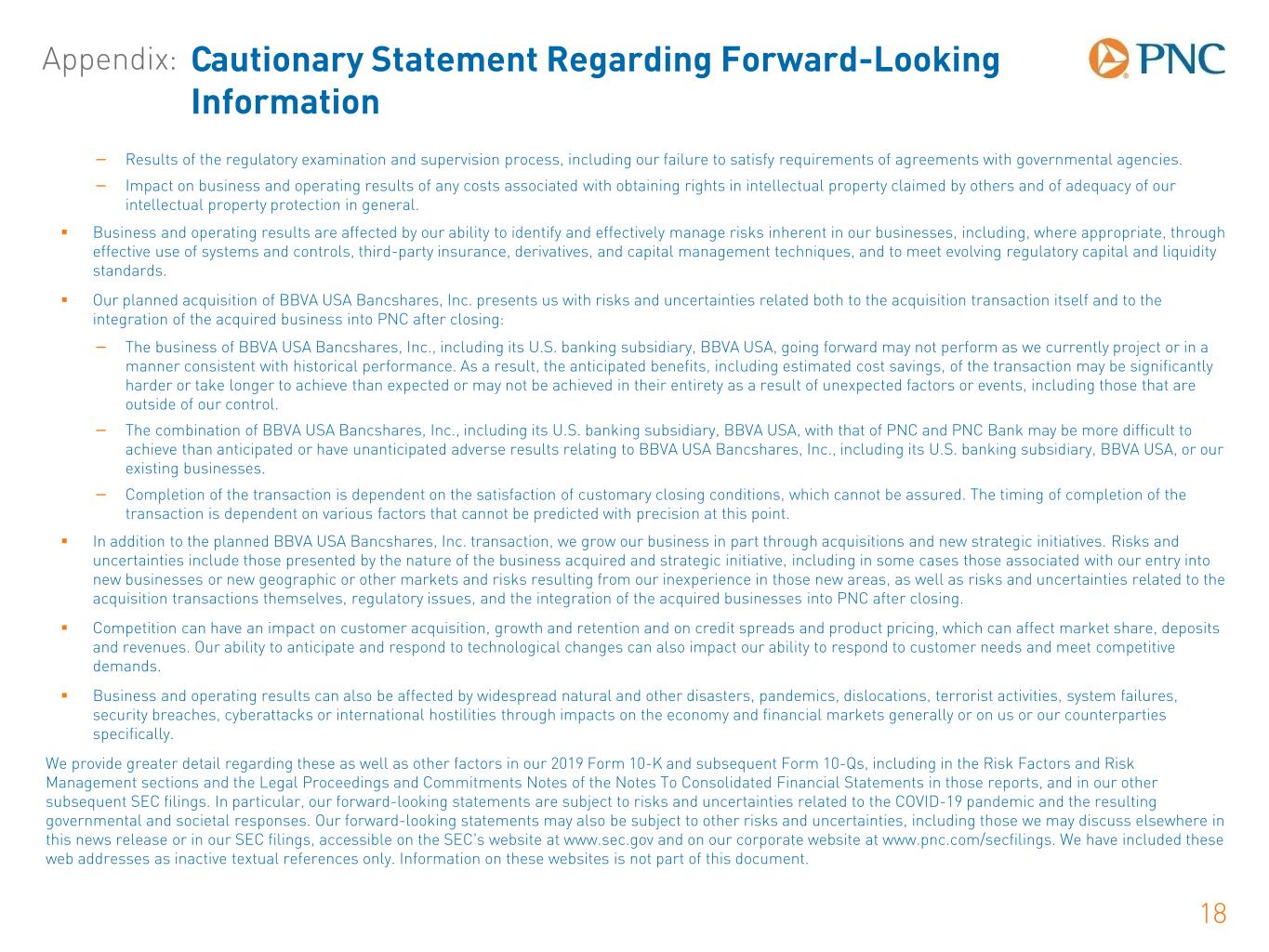
− Results of the regulatory examination and supervision process, including our failure to satisfy requirements of agreements with governmental agencies. − Impact on business and operating results of any costs associated with obtaining rights in intellectual property claimed by others and of adequacy of our intellectual property protection in general. Business and operating results are affected by our ability to identify and effectively manage risks inherent in our businesses, including, where appropriate, through effective use of systems and controls, third-party insurance, derivatives, and capital management techniques, and to meet evolving regulatory capital and liquidity standards. Our planned acquisition of BBVA USA Bancshares, Inc. presents us with risks and uncertainties related both to the acquisition transaction itself and to the integration of the acquired business into PNC after closing: − The business of BBVA USA Bancshares, Inc., including its U.S. banking subsidiary, BBVA USA, going forward may not perform as we currently project or in a manner consistent with historical performance. As a result, the anticipated benefits, including estimated cost savings, of the transaction may be significantly harder or take longer to achieve than expected or may not be achieved in their entirety as a result of unexpected factors or events, including those that are outside of our control. − The combination of BBVA USA Bancshares, Inc., including its U.S. banking subsidiary, BBVA USA, with that of PNC and PNC Bank may be more difficult to achieve than anticipated or have unanticipated adverse results relating to BBVA USA Bancshares, Inc., including its U.S. banking subsidiary, BBVA USA, or our existing businesses. − Completion of the transaction is dependent on the satisfaction of customary closing conditions, which cannot be assured. The timing of completion of the transaction is dependent on various factors that cannot be predicted with precision at this point. In addition to the planned BBVA USA Bancshares, Inc. transaction, we grow our business in part through acquisitions and new strategic initiatives. Risks and uncertainties include those presented by the nature of the business acquired and strategic initiative, including in some cases those associated with our entry into new businesses or new geographic or other markets and risks resulting from our inexperience in those new areas, as well as risks and uncertainties related to the acquisition transactions themselves, regulatory issues, and the integration of the acquired businesses into PNC after closing. Competition can have an impact on customer acquisition, growth and retention and on credit spreads and product pricing, which can affect market share, deposits and revenues. Our ability to anticipate and respond to technological changes can also impact our ability to respond to customer needs and meet competitive demands. Business and operating results can also be affected by widespread natural and other disasters, pandemics, dislocations, terrorist activities, system failures, security breaches, cyberattacks or international hostilities through impacts on the economy and financial markets generally or on us or our counterparties specifically. We provide greater detail regarding these as well as other factors in our 2019 Form 10-K and subsequent Form 10-Qs, including in the Risk Factors and Risk Management sections and the Legal Proceedings and Commitments Notes of the Notes To Consolidated Financial Statements in those reports, and in our other subsequent SEC filings. In particular, our forward-looking statements are subject to risks and uncertainties related to the COVID-19 pandemic and the resulting governmental and societal responses. Our forward-looking statements may also be subject to other risks and uncertainties, including those we may discuss elsewhere in this news release or in our SEC filings, accessible on the SEC’s website at www.sec.gov and on our corporate website at www.pnc.com/secfilings. We have included these web addresses as inactive textual references only. Information on these websites is not part of this document. 18 Appendix: Cautionary Statement Regarding Forward-Looking Information
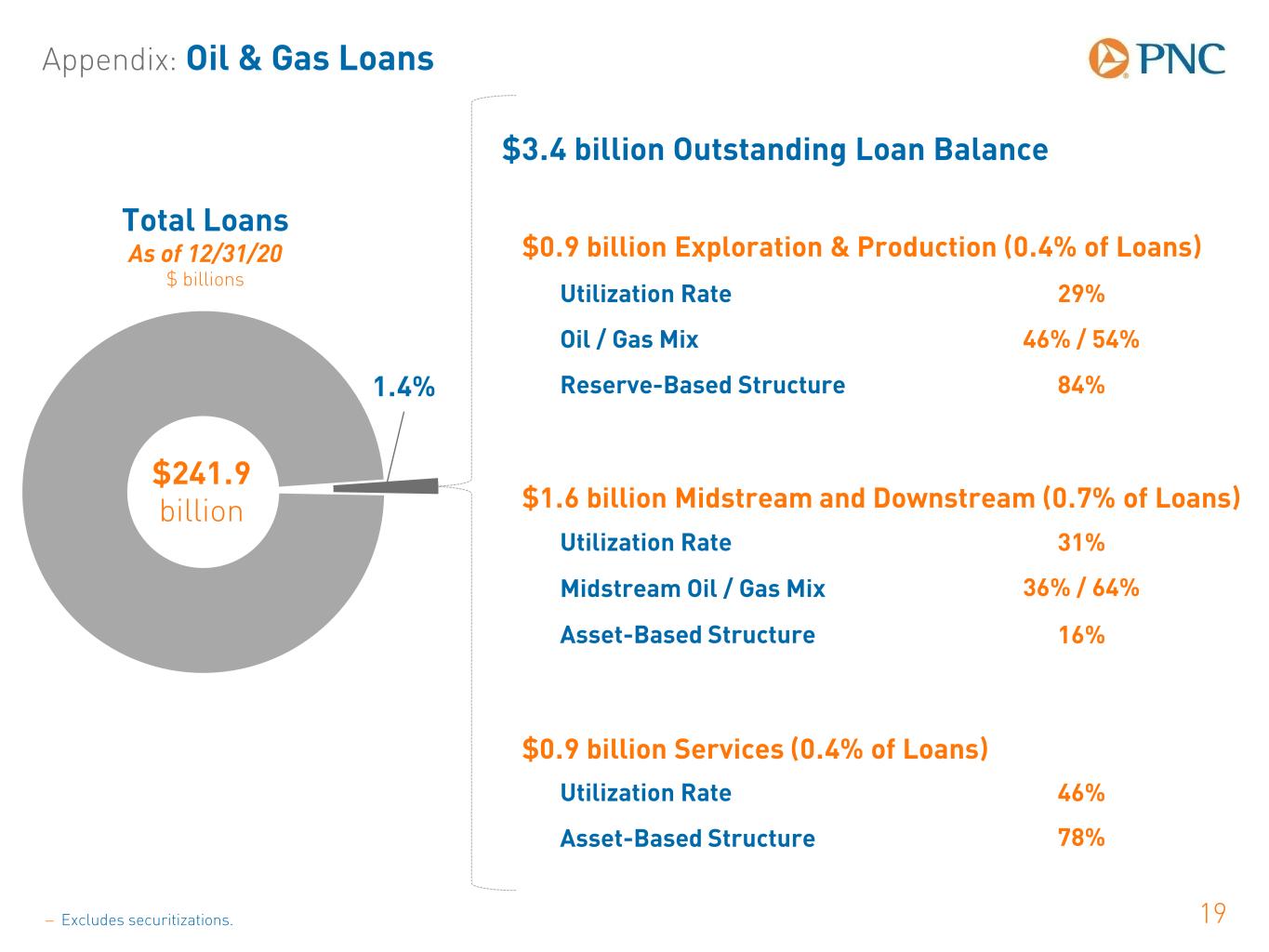
Appendix: Oil & Gas Loans 19 1.4% $241.9 billion − Excludes securitizations. Total Loans As of 12/31/20 $ billions $0.9 billion Exploration & Production (0.4% of Loans) Utilization Rate 29% $3.4 billion Outstanding Loan Balance Oil / Gas Mix 46% / 54% Reserve-Based Structure 84% $1.6 billion Midstream and Downstream (0.7% of Loans) $0.9 billion Services (0.4% of Loans) Utilization Rate 46% Asset-Based Structure 78% Utilization Rate 31% Midstream Oil / Gas Mix 36% / 64% Asset-Based Structure 16%
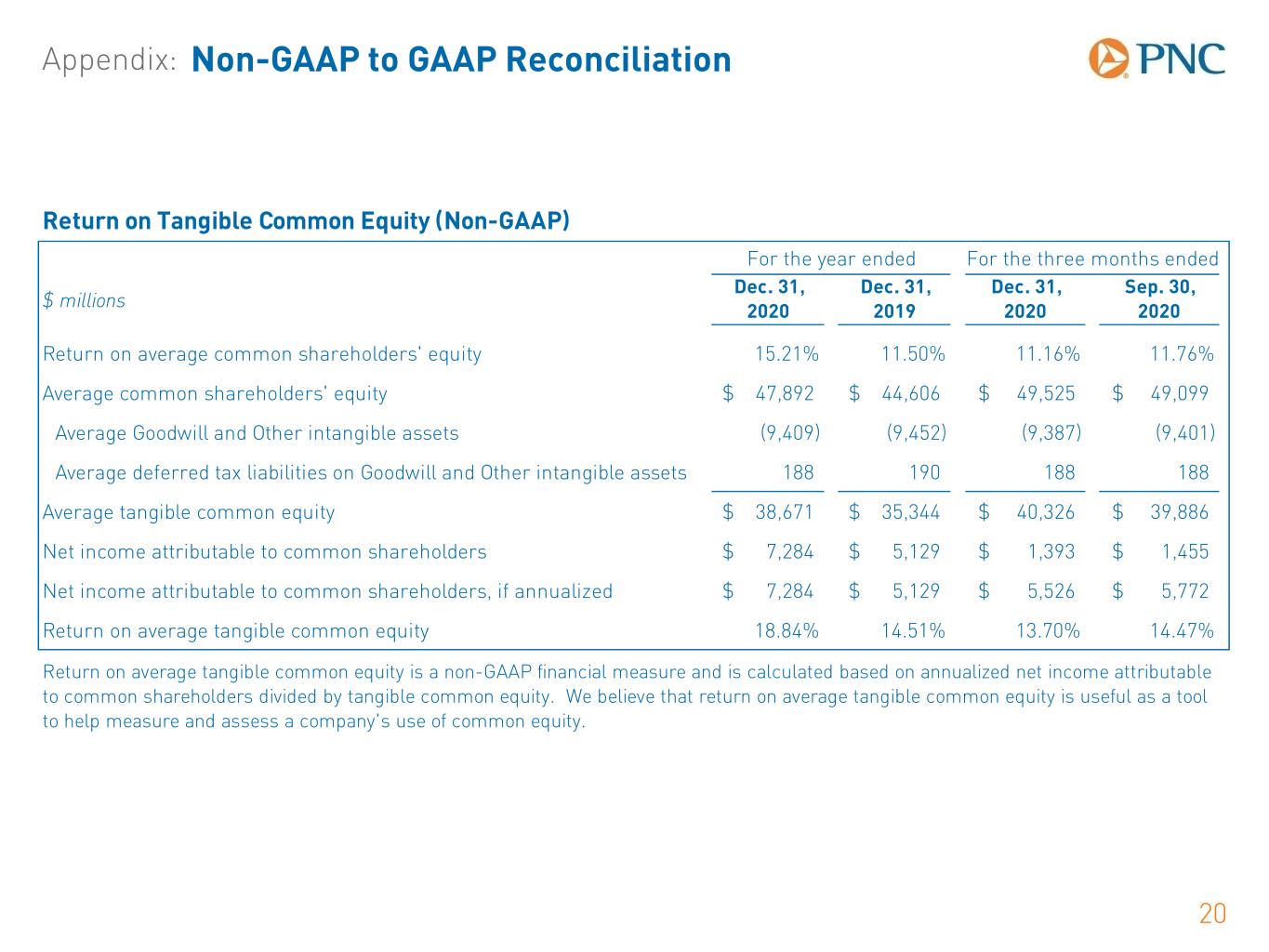
Appendix: Non-GAAP to GAAP Reconciliation 20 Return on Tangible Common Equity (Non-GAAP) $ millions Dec. 31, 2020 Dec. 31, 2019 Dec. 31, 2020 Sep. 30, 2020 Return on average common shareholders' equity 15.21% 11.50% 11.16% 11.76% Average common shareholders' equity 47,892$ 44,606$ 49,525$ 49,099$ Average Goodwill and Other intangible assets (9,409) (9,452) (9,387) (9,401) Average deferred tax liabilities on Goodwill and Other intangible assets 188 190 188 188 Average tangible common equity 38,671$ 35,344$ 40,326$ 39,886$ Net income attributable to common shareholders 7,284$ 5,129$ 1,393$ 1,455$ Net income attributable to common shareholders, if annualized 7,284$ 5,129$ 5,526$ 5,772$ Return on average tangible common equity 18.84% 14.51% 13.70% 14.47% Return on average tangible common equity is a non-GAAP financial measure and is calculated based on annualized net income attributable to common shareholders divided by tangible common equity. We believe that return on average tangible common equity is useful as a tool to help measure and assess a company's use of common equity. For the three months endedFor the year ended
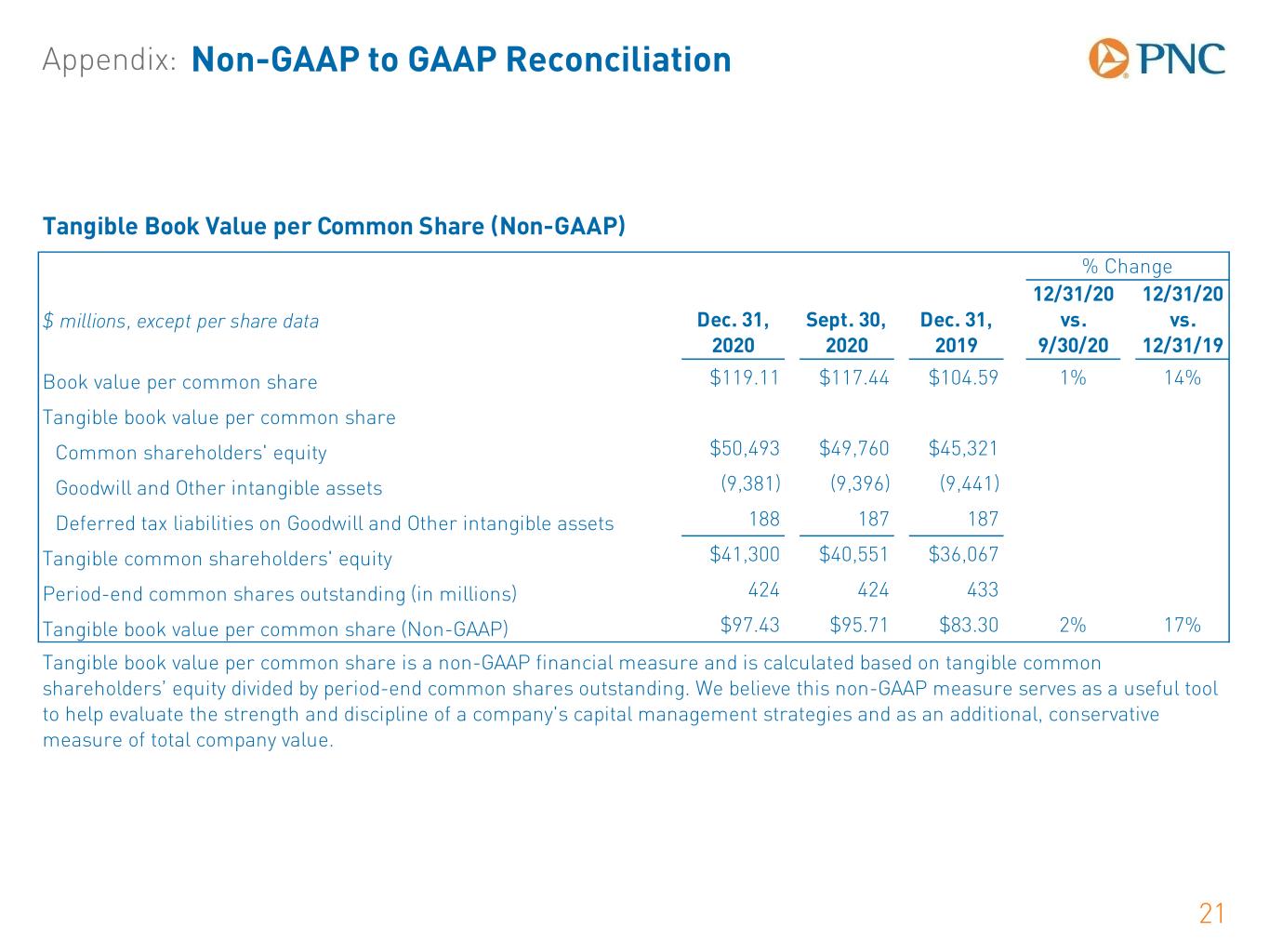
Appendix: Non-GAAP to GAAP Reconciliation 21 Tangible Book Value per Common Share (Non-GAAP) $ millions, except per share data Dec. 31, 2020 Sept. 30, 2020 Dec. 31, 2019 12/31/20 vs. 9/30/20 12/31/20 vs. 12/31/19 Book value per common share $119.11 $117.44 $104.59 1% 14% Tangible book value per common share Common shareholders' equity $50,493 $49,760 $45,321 Goodwill and Other intangible assets (9,381) (9,396) (9,441) Deferred tax liabilities on Goodwill and Other intangible assets 188 187 187 Tangible common shareholders' equity $41,300 $40,551 $36,067 Period-end common shares outstanding (in millions) 424 424 433 Tangible book value per common share (Non-GAAP) $97.43 $95.71 $83.30 2% 17% % Change Tangible book value per common share is a non-GAAP financial measure and is calculated based on tangible common shareholders’ equity divided by period-end common shares outstanding. We believe this non-GAAP measure serves as a useful tool to help evaluate the strength and discipline of a company's capital management strategies and as an additional, conservative measure of total company value.

Appendix: Non-GAAP to GAAP Reconciliation 22 % Change % Change Dec. 31, 2020 Dec. 31, 2019 2020 vs. 2019 Dec. 31, 2020 Sep. 30, 2020 4Q20 vs. 3Q20 $9,946 $9,965 (0%) $2,424 $2,484 (2%) 6,955 6,874 1% 1,784 1,797 (1%) $16,901 $16,839 0% $4,208 $4,281 (2%) 10,297 10,574 (3%) 2,708 2,531 7% $6,604 $6,265 5% $1,500 $1,750 (14%) $3,003 $4,591 (35%) $1,456 $1,532 (5%) For the three months ended Pretax, Pre-Provision Earnings (Non-GAAP) We believe that pretax, pre-provision earnings, a non-GAAP financial measure, is useful as a tool to help evaluate the ability to provide for credit costs through operations. $ millions Net interest income Noninterest income Total revenue Noninterest expense Pretax pre-provision earnings Net income from continuing operations For the year ended